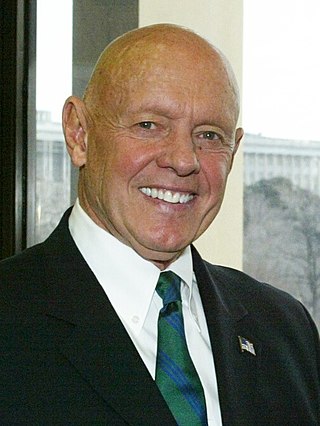Virtual management, is the supervision, leadership, and maintenance of virtual teams—dispersed work groups that rarely meet face to face. As the number of virtual teams has grown, facilitated by the Internet, globalization, outsourcing, and remote work, the need to manage them has also grown. The following article provides information concerning some of the important management factors involved with virtual teams, and the life cycle of managing a virtual team.

Leadership, both as a research area and as a practical skill, encompasses the ability of an individual, group or organization to "lead", influence or guide other individuals, teams, or entire organizations. The word "leadership" often gets viewed as a contested term. Specialist literature debates various viewpoints on the concept, sometimes contrasting Eastern and Western approaches to leadership, and also North American versus European approaches.

A team is a group of individuals working together to achieve their goal.
Organization development (OD)is an goals primarily called based totally technique to structures alternative inside an business enterprise. The organizational changes are typically initiated by the group's stakeholders. OD emerged from human relations studies in the 1930s, during which psychologists realized that organizational structures and processes influence worker behavior and motivation. Organization Development allows businesses to comstruct and maintain a brand new preferred state for the whole agency. Key concepts of OD theory include: organizational climate, organizational culture and organizational strategies.
Intrapersonal communication is the process by which an individual communicates within themselves, acting as both sender and receiver of messages, and encompasses the use of unspoken words to consciously engage in self-talk and inner speech.
Historically there have been differences among investigators regarding the definition of organizational culture. Edgar Schein, a leading researcher in this field, defined "organizational culture" as comprising a number of features, including a shared "pattern of basic assumptions" which group members have acquired over time as they learn to successfully cope with internal and external organizationally relevant problems. Elliott Jaques first introduced the concept of culture in the organizational context in his 1951 book The Changing Culture of a Factory. The book was a published report of "a case study of developments in the social life of one industrial community between April, 1948 and November 1950". The "case" involved a publicly-held British company engaged principally in the manufacture, sale, and servicing of metal bearings. The study concerned itself with the description, analysis, and development of corporate group behaviours.

Stephen Richards Covey was an American educator, author, businessman, and keynote speaker. His most popular book is The 7 Habits of Highly Effective People. His other books include First Things First, Principle-Centered Leadership, The 7 Habits of Highly Effective Families, The 8th Habit, and The Leader In Me: How Schools and Parents Around the World Are Inspiring Greatness, One Child at a Time. In 1996, Time magazine named him one of the 25 most influential people. He was a professor at the Jon M. Huntsman School of Business at Utah State University at the time of his death.

The 7 Habits of Highly Effective People, first published in 1989, is a business and self-help book written by Stephen R. Covey. Covey presents an approach to being effective in attaining goals by aligning oneself to what he calls "true north" principles based on a character ethic that he presents as universal and timeless.
Communications management is the systematic planning, implementing, monitoring, and revision of all the channels of communication within an organization and between organizations. It also includes the organization and dissemination of new communication directives connected with an organization, network, or communications technology. Aspects of communications management include developing corporate communication strategies, designing internal and external communications directives, and managing the flow of information, including online communication. It is a mere process that helps an organization to be systematic as one within the bounds of communication.
In business management, a learning organization is a company that facilitates the learning of its members and continuously transforms itself. The concept was coined through the work and research of Peter Senge and his colleagues.
Transformational leadership is a theory of leadership where a leader works with teams or followers beyond their immediate self-interests to identify needed change, creating a vision to guide the change through influence, inspiration, and executing the change in tandem with committed members of a group; This change in self-interests elevates the follower's levels of maturity and ideals, as well as their concerns for the achievement. it is an integral part of the Full Range Leadership Model. Transformational leadership is when leader behaviors influence followers and inspire them to perform beyond their perceived capabilities. Transformational leadership inspires people to achieve unexpected or remarkable results. It gives workers autonomy over specific jobs, as well as the authority to make decisions once they have been trained. This induces a positive change in the followers attitudes and the organization as a whole. Transformational leaders typically perform four distinct behaviors, also known as the four I's. These behaviors are inspirational motivation, idealized influence, intellectual stimulation, individualized consideration.
Transactional leadership or transactional management is the part of one style of leadership that focuses on supervision, organization, and performance; it is an integral part of the Full Range Leadership Model. This type of management was born during the Industrial Revolution as a source of competitive advantage. Some typical tactics of this type of management include strategy, efficiency goals, economies of scale and quality differentiation. Transactional managers focus on performance related tasks and goals.
Personal development or self improvement consists of activities that develop a person's capabilities and potential, build human capital, facilitate employability, and enhance quality of life and the realization of dreams and aspirations. Personal development may take place over the course of an individual's entire lifespan and is not limited to one stage of a person's life. It can include official and informal actions for developing others in roles such as teacher, guide, counselor, manager, coach, or mentor, and it is not restricted to self-help. When personal development takes place in the context of institutions, it refers to the methods, programs, tools, techniques, and assessment systems offered to support positive adult development at the individual level in organizations.
Change management is a collective term for all approaches to prepare, support, and help individuals, teams, and organizations in making organizational change. It includes methods that redirect or redefine the use of resources, business process, budget allocations, or other modes of operation that significantly change a company or organization.
Entrepreneurship is the creation or extraction of economic value. With this definition, entrepreneurship is viewed as change, generally entailing risk beyond what is normally encountered in starting a business, which may include other values than simply economic ones.
Leadership studies is a multidisciplinary academic field of study that focuses on leadership in organizational contexts and in human life. Leadership studies has origins in the social sciences, in humanities, as well as in professional and applied fields of study. The field of leadership studies is closely linked to the field of organizational studies.
Leader development is defined as the "expansion of a person's capacity to be effective in leadership roles and processes". These roles and processes are ones that aid in setting direction, creating alignment and maintaining commitment in groups of people sharing common work. Most organizational leadership research and educational programs have focused on developing individual-based knowledge, skills, and abilities associated with formal leadership roles of individuals. Leader development therefore results by investing in human capital.
A leadership style is a leader's method of providing direction, implementing plans, and motivating people. Various authors have proposed identifying many different leadership styles as exhibited by leaders in the political, business or other fields. Studies on leadership style are conducted in the military field, expressing an approach that stresses a holistic view of leadership, including how a leader's physical presence determines how others perceive that leader. The factors of physical presence in this context include military bearing, physical fitness, confidence, and resilience. A leader's conceptual abilities include agility, judgment, innovation, interpersonal tact, and domain knowledge. Leaders are characterized as individuals who have differential influence over the setting of goals, logistics for coordination, monitoring of effort, and rewards and punishment of group members. Domain knowledge encompasses tactical and technical knowledge as well as cultural and geopolitical awareness.
Work motivation "is a set of energetic forces that originate both within as well as beyond an individual's being, to initiate work-related behavior, and to determine its form, direction, intensity, and duration." Understanding what motivates an organization's employees is central to the study of I–O psychology. Motivation is a person's internal disposition to be concerned with and approach positive incentives and avoid negative incentives. To further this, an incentive is the anticipated reward or aversive event available in the environment. While motivation can often be used as a tool to help predict behavior, it varies greatly among individuals and must often be combined with ability and environmental factors to actually influence behavior and performance. Results from a 2012 study, which examined age-related differences in work motivation, suggest a "shift in people's motives" rather than a general decline in motivation with age. That is, it seemed that older employees were less motivated by extrinsically related features of a job, but more by intrinsically rewarding job features. Work motivation is strongly influenced by certain cultural characteristics. Between countries with comparable levels of economic development, collectivist countries tend to have higher levels of work motivation than do countries that tend toward individualism. Similarly measured, higher levels of work motivation can be found in countries that exhibit a long versus a short-term orientation. Also, while national income is not itself a strong predictor of work motivation, indicators that describe a nation's economic strength and stability, such as life expectancy, are. Work motivation decreases as a nation's long-term economic strength increases. Currently work motivation research has explored motivation that may not be consciously driven. This method goal setting is referred to as goal priming. Effects of primed subconscious goals in addition to goals that are consciously set related to job performance have been studied by Stajkovic, Latham, Sergent, and Peterson, who conducted research on a CEO of a for-profit business organization using goal priming to motivate job performance. Goal priming refers to the achievement of a goal by external cues given. These cues can affect information processing and behaviour the pursuit of this goal. In this study, the goal was primed by the CEO using achievement related words strategy placed in emails to employees. This seemingly small gesture alone not only cost the CEO very little money, but it increased objectively measured performance efficiency by 35% and effectiveness by 15% over the course of a 5-day work week. There has been controversy about the true efficacy of this work as to date, only four goal priming experiments have been conducted. However, the results of these studies found support for the hypothesis that primed goals do enhance performance in a for-profit business organization setting.
The Three Levels of Leadership is a leadership model formulated in 2011 by James Scouller. Designed as a practical tool for developing a person's leadership presence, knowhow and skill, it aims to summarize what leaders have to do, not only to bring leadership to their group or organization, but also to develop themselves technically and psychologically as leaders. It has been classified as an "integrated psychological" theory of leadership. It is sometimes known as the 3P model of leadership.



